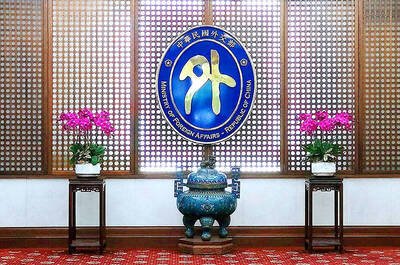With next month’s Energy Conference around the corner, academics yesterday put forth possible solutions for reshaping the nation’s energy sector, with some saying that using more coal alongside carbon dioxide capture and sequestration would greatly reduce energy costs with minimal environmental fallout, freeing up the capital required to fund the long-term development of alternative power sources.
Tamkang University chemistry professor Kao Hui-chun (高惠春) told a news conference in Taipei that Taiwan has great potential to develop renewable energy, as it is blessed with an abundance of alternative sources.
Citing research conducted by the Taiwan Association of University Professors, Kao said the nation is capable of generating up to 1.25 trillion kilowatt-hours (kWh) of renewable energy annually — five times the total amount consumed nationwide in 2012 — with sunlight and wind estimated to be able to generate about 450 billion and 250 billion kWh respectively.
Geothermal and ocean thermal energy conversion could provide an additional 200 billion kWh and 350 billion kWh of energy respectively every year, she added.
With respect to heating, Kao said the nation in 2012 consumed 1,320 gigajoules of heat and that 800 gigajoules of this demand can be covered by biomass energy.
Lin Li-fu (林立夫), a research fellow at the Institute of Nuclear Energy Research, said Taiwan produces only 3 percent of the energy it consumes, making it extremely vulnerable to international energy price fluctuations.
The problem is manifested in Taiwan’s energy cost-GDP ratio, which has soared from about 4 percent in 2003 to 13 percent in recent years, he said.
Lin said the top priority in policymaking is lowering the nation’s dependence on imported energy by investing in advanced technologies to widen its power resources, which in turn would drive economic growth and create jobs.
On the policy of raising the proportion of the nation’s energy supply derived from natural gas from 12 to 25 percent, as touted by President Ma Ying-jeou’s (馬英九) administration, Lin said that natural gas is a pricey import — at about NT$4.6 per kWh — so the government should abandon this tact.
Instead, Lin said the government should make coal, which has an energy cost about half that of natural gas, the main source of power, while employing carbon dioxide capture storage to cap emissions as an alternative energy infrastructure is developed.
He also suggested that industries improve energy efficiency by introducing value-added products. For example, iPhones and smartphones made domestically consume equal amounts of energy during manufacturing, but the former has much more added value derived from its innovativeness.
“GDP growth and energy efficiency are related. One cannot expect to boost energy efficiency without also pursuing GDP growth,” he said.

The Ministry of Foreign Affairs (MOFA) yesterday voiced dissatisfaction with the Comprehensive and Progressive Agreement for Trans- Pacific Partnership (CPTPP), whose latest meeting, concluded earlier the same day, appeared not to address the country’s application. In a statement, MOFA said the CPTPP commission had "once again failed to fairly process Taiwan’s application," attributing the inaction to the bloc’s "succumbing to political pressure," without elaborating. Taiwan submitted its CPTPP application under the name "Separate Customs Territory of Taiwan, Penghu, Kinmen and Matsu" on Sept. 22, 2021 -- less than a week after China

ALIGNED THINKING: Taiwan and Japan have a mutual interest in trade, culture and engineering, and can work together for stability, Cho Jung-tai said Taiwan and Japan are two like-minded countries willing to work together to form a “safety barrier” in the Indo-Pacific region, Premier Cho Jung-tai (卓榮泰) yesterday said at the opening ceremony of the 35th Taiwan-Japan Modern Engineering and Technology Symposium in Taipei. Taiwan and Japan are close geographically and closer emotionally, he added. Citing the overflowing of a barrier lake in the Mataian River (馬太鞍溪) in September, Cho said the submersible water level sensors given by Japan during the disaster helped Taiwan monitor the lake’s water levels more accurately. Japan also provided a lot of vaccines early in the outbreak of the COVID-19 pandemic,

Kaohsiung Mayor Chen Chi-mai (陳其邁) on Monday announced light shows and themed traffic lights to welcome fans of South Korean pop group Twice to the port city. The group is to play Kaohsiung on Saturday as part of its “This Is For” world tour. It would be the group’s first performance in Taiwan since its debut 10 years ago. The all-female group consists of five South Koreans, three Japanese and Tainan’s Chou Tzu-yu (周子瑜), the first Taiwan-born and raised member of a South Korean girl group. To promote the group’s arrival, the city has been holding a series of events, including a pop-up

A home-style restaurant opened by a Taiwanese woman in Quezon City in Metro Manila has been featured in the first-ever Michelin Guide honoring exceptional restaurants in the Philippines. The restaurant, Fong Wei Wu (豐味屋), was one of 74 eateries to receive a “Michelin Selected” honor in the guide, while one restaurant received two Michelin stars, eight received one star and 25 were awarded a “Bib Gourmand.” The guide, which was limited to restaurants in Metro Manila and Cebu, was published on Oct. 30. In an interview, Feng Wei Wu’s owner and chef, Linda, said that as a restaurateur in her 60s, receiving an